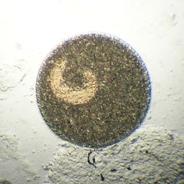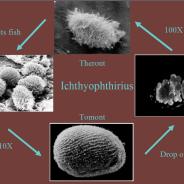Ichthyophthirius multifiliis is a common pathogen of freshwater fish, particularly in aquaria. It is a protozoan (single-celled) ectoparasite, which often appears as white spots that resemble grains of salt up to 1/16th inch in diameter on the skin, fins and gills of infected fish. Each white spot is an encysted parasite. It is easily introduced into aquaria or ponds when new infected fish or water are added. The organism is difficult to control and eliminate due to its rapid, direct life cycle. The parasite damages the fish skin and gills, making it difficult for the fish to control its water levels. Gill damage makes oxygen uptake difficult, especially when water quality is poor. Infected fish usually die without treatment. The parasite is not harmful to humans.
also known as
White Spot disease
Ich
Distribution
worldwide, in aquaria
Hosts
Freshwater fish
Detection Methods:
gross pathology / gross clinical signs
microscopic exam - histology
microscopic exam - wet mount
Target tissue
Skin
References



